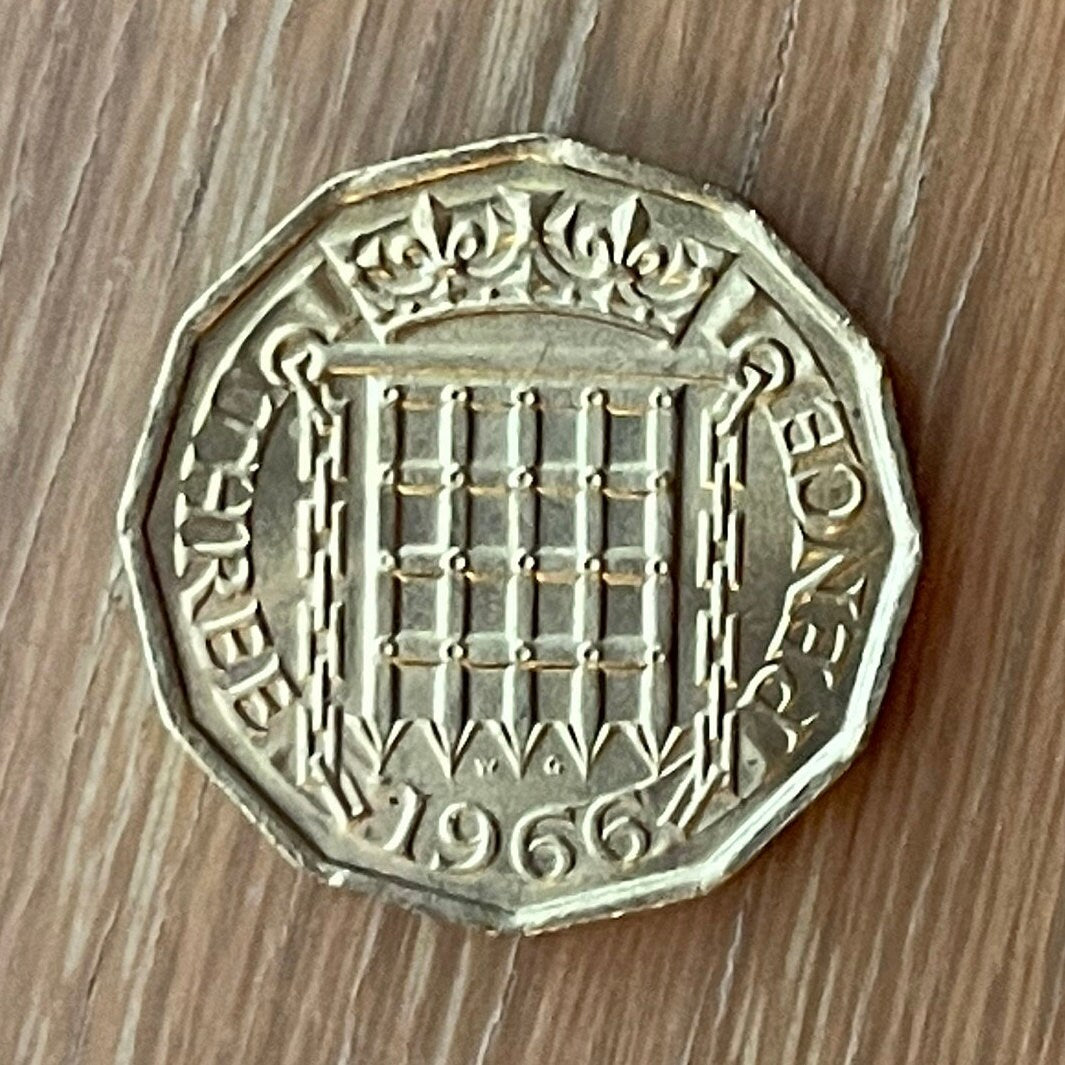elemintalshop
Crowned Portcullis of Parliament 3 Pence Great Britain Authentic Coin Money for Jewelry (Palace of Westminster) (Tudor) (House of Commons)
Crowned Portcullis of Parliament 3 Pence Great Britain Authentic Coin Money for Jewelry (Palace of Westminster) (Tudor) (House of Commons)
Couldn't load pickup availability
Crowned Portcullis of Parliament 3 Pence Great Britain Authentic Coin Money for Jewelry and Craft Making (Palace of Westminster) (Beaufort) (Tudor) (House of Commons)
Reverse: A Tudor Beaufort Portcullis and side chains with crown above, dividing value, date below
Lettering: THREE 1967 PENCE
Obverse: Young laureate portrait of HM Queen Elizabeth II facing right, legend around.Lettering: + ELIZABETH·II·DEI·GRATIA·REGINA·F:D:
Translation: Elizabeth the Second by the Grace of God Queen Defender of the Faith (Elizabeth II Dei Gratia Regina Fidei Defensatrix)
Features
Issuer United Kingdom
Queen Elizabeth II (1952-date)
Type Standard circulation coin
Years 1954-1970
Value 3 Pence = 1/4 Shilling (1/80)
Currency Pound sterling (1158-1970)
Composition Nickel brass
Weight 6.8 g
Diameter 21.8 mm
Thickness 2.6 mm
Shape Dodecagonal (12-sided)
Orientation Medal alignment ↑↑
Demonetized 08-31-1971
Number N# 71
References KM# 900, Sp# 4153
Since 1967, the crowned portcullis has been used exclusively on House of Commons stationery. ... The portcullis probably came to be associated with the Palace of Westminster through its use, along with Tudor roses, fleurs-de-lys and pomegranates, as decoration in the rebuilding of the Palace after the fire of 1512. The portcullis was the badge of John Beaufort, Marquess of Dorset and Somerset (c.1371-1410), bastard son of John of Gaunt, Duke of Lancaster (1340-1399), and was subsequently adopted by his great-grandson, Henry Tudor (later Henry VII) whose mother was Lady Margaret Beaufort (1443-1509). Henry VII (1485-1509) and Henry VIII (1509-1547), the first and second sovereigns of the Tudor dynasty, employed the portcullis as a badge and probably used it in the Palace, as elsewhere. It was under the Tudors that the Palace of Westminster ceased to be the seat of the Court and became the regular meeting place of Parliament. The portcullis as now used in the Palace of Westminster is commonly surmounted by a crown, which makes it specifically a royal symbol, even though the original use by the Beauforts was of an uncrowned portcullis. There has been little consistency about inclusion of the crown over the years. --
https://www.parliament.uk/globalassets/documents/commons-information-office/g09.pdf
Wikipedia:
A portcullis (from Old French porte coleice, "sliding gate", is a heavy vertically-closing gate typically found in Medieval fortifications, consisting of a latticed grille made of wood, metal, or a combination of the two, which slides down grooves inset within each jamb of the gateway.
The portcullis was the heraldic badge of the House of Beaufort, and the first Tudor king, Henry VII, who was of matrilineal Beaufort descent, adapted both the portcullis and the Tudor rose into Royal badges of the House of Tudor. Since then, the portcullis has been a moderately common motif of English heraldry, especially that heraldry dating from the Tudor period.
Although the Palace of Westminster served as the official royal residence for both Henry VII and Henry VIII until 1530, the current use of the portcullis as a symbol of the Palace and of Parliament does not date from that time. Rather, the symbol was developed as part of Sir Charles Barry's plans for the rebuilt Palace after the original burned down on 16 October 1834; he conceptualized the new Palace as a "legislative castle", and the symbol of a castle gate—i.e. a portcullis—fitted well with the scheme.
Since then, the portcullis has become the primary symbol of Parliament; an office building for Members of Parliament (MPs), opened in 2001, is named "Portcullis House". During the 20th century, use of the portcullis as a symbol of Parliament spread beyond Britain and to the other Commonwealth realms; for instance, the coat of arms of Canberra features a portcullis in its crest, preserving a connection between the British Parliament at Westminster and the Australian Parliament to which Canberra is home.
Share



















